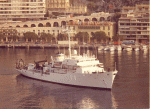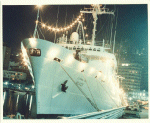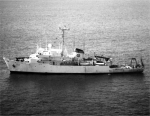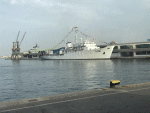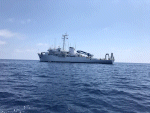
05033501 |
38k |
Namesake
Charles Wilkes was born on 3 April 1798 in New York City. He served in merchant ships between 1815 and 1817 before being appointed a midshipman in the United States Navy on New Year's Day 1818. Following initial training in Independence, he transferred to Guerriere in July 1818 for a cruise in the Baltic and Mediterranean Seas. After a two-month assignment in Washington between March and May 1821, Midshipman Wilkes received orders to Franklin, in which ship he voyaged to South America. During that cruise, Wilkes briefly commanded Franklin's tender Waterwitch before being detached from Franklin on 3 March 1823 to command the American merchant ship Ocain on her way back to Boston, where he arrived on 15 October. From there, he reported to Washington for duty in conjunction with the court-martial of Capt. Stewart, his former commanding officer in Franklin. On 28 April 1827, Wilkes was promoted to lieutenant. Apparently at home awaiting orders between 1826 and 1830, Lt. Wilkes requested surveying duty in March of 1827 but withdrew his application in July 1828 in favor of one for duty with a proposed exploring expedition. Late that fall, he received orders to New York where he set about the task of procuring the necessary instruments for that expedition. In April 1830, Lt. Wilkes resumed sea duty. Assigned to Boston, he made a cruise in her to the Mediterranean. On 15 November, he transferred to Fair-field in which ship he served until May 1831 at which time he was detached and ordered home to await orders. Late in the spring of 1832, Wilkes returned to active duty as a member of the team which surveyed Narragansett Bay. In February 1833, he received orders to duty in charge of the Depot of Charts and Instruments (forerunner both of the Naval Oceano-graphic Office and of the Naval Observatory). In August of 1836, Wilkes briefly took leave of that post when he sailed to Europe to acquire additional equipment for the exploring expedition. He returned to the Depot of Charts and Instruments after that trip; and, in March 1837, Secretary of the Navy Mahlon Dicker-son requested Wilkes to take a position in the astronomy department of the exploring expedition. That fall, he participated in an oceanographic survey of the Carolina coast. The following spring, Wilkes learned that he had been chosen to command the South Seas Exploring Expedition. President Van Buren approved his appointment on 20 April, and Wilkes assumed command of Vincennes at Norfolk on 7 July. He received his final orders on 11 August and set sail in Vincennes in company with Peacock, Porpoise, Sea Gull, Flying Fish, and Relief—on the 18th. After stops at Rio de Janeiro, Brazil, and Tierra del Fuego located at the southern tip of South America, Wilkes took his expedition on its first cruise through Antarctic waters in February and March of 1839. He returned to Tierra del Fuego and then later headed through the south seas to Sydney, Australia, where he arrived on 29 November. On the day after Christmas, he embarked upon his second voyage to the Antarctic. In January 1840, he sighted the actual land mass which constitutes Antarctica, though it took later explorations to vindicate his assertions that the continent existed. By late spring 1840, the expedition moved north again and began the exploration of the islands of the South Pacific. After surveying the Fiji Islands between May and August, the expedition departed those islands, bound for Hawaii on 11 August. The Hawaiian survey, conducted between 24 September 1840 and 5 April 1841, centered upon a study of the volcanoes, Mauna Loa and Kilauea. Wilkes completed his work in Hawaii in April 1841 and set sail on the 5th for the west coast. After surveys of parts of the coast of the Pacific Northwest during the summer of 1841, he brought his expedition into San Francisco on 14 August. Its arrival back in the United States, however, signaled no end to the work of the expedition. On 1 November, it put to sea once again, this time for a voyage to the western Pacific. During that cruise, Wilkes visited Manila in the Philippines, the British colony at Singapore, and Cape Town on the southern tip of Africa. Wilkes and his command concluded the expedition upon arrival at New York on 10 June 1842. For almost 19 years, Wilkes worked with the data gathered by his expedition. During that period, he supervised the publication of the results of that exploration in a series of Narratives under the auspices of the Navy. He also received two promotions during that time to commander in 1843 and to captain in 1855. The only break in this duty came in the second half of 1858 when the Secretary of the Navy sent Wilkes on a special mission to evaluate the potential for naval use of the natural resources primarily iron, coal, and timber of North Carolina's Deep River region. The outbreak of the Civil War, however, brought an interruption to his scientific work. On 19 April, he was detached from his duty with the expedition publication program in order to help destroy the Norfolk Navy Yard before Union forces abandoned it to the Confederacy. In May, Capt. Wilkes received orders to take command of the steam-powered frigate San Jacinto. He arrived on board his new command on 27 August, at Monrovia, Liberia, just before she set sail to return to the United States. During the voyage home, he took her to the West Indies in search of the Southern commerce raider, CSS Sumter, under the command of Capt. Raphael Semmes later commanding officer of the famous Confederate cruiser CSS Alabama. During that mission, his ship stopped at Cienfuegos, Cuba, for coal, and Wilkes learned that the South's commissioners to England and France, James Mason and John Slidell, had escaped from Charleston on board the fast coastal packet Theodora and were then in Havana awaiting transportation to Europe. San Jacinto quickly headed for Havana, hoping to catch Theodora when she embarked upon her return trip but arrived a day late. He learned, however, that Mason and Slidell were still in Cuba and planned to board the British mail packet Trent at St. Thomas for the voyage to Europe. Thereupon, he concocted a plan to intercept Trent in Old Bahama Channel, some 230 miles east of Havana, and capture the two Confederate diplomats. On 8 November, the British ship steamed into sight, and Wilkes coerced her into stopping with two shots across her bow. A boarding party seized Mason and Slidell and their secretaries and then allowed the neutral ship to continue her voyage. San Jacinto then headed home with her prisoners. Upon his arrival in Boston, Wilkes was loudly acclaimed for his action, but soon the clouds of war with Great Britain over the incident began to darken the horizon. Ultimately, the dubious legality of Wilkes' action and the threat of war with Britain and France brought a complete disavowal of Wilkes' act by the Federal Government and the release of the prisoners. On 30 November, Capt. Wilkes was detached from San Jacinto and ordered to duty with the Board of Naval Examiners. That assignment lasted until the following summer. He commanded the James River Flotilla briefly in July and August of 1862 and received his promotion to commodore at that time. On 29 August, Wilkes left that post and took over the Potomac River Flotilla. That assignment proved to be of short duration. On 8 September, he received orders to command the West India Squadron. Promoted to acting rear admiral, Wilkes directed the West India Squandron—primarily concerned with hunting down Southern commerce raiders and blockade runners—until the summer of 1863. On 1 June, he was detached from the squadron and, on the 30th, set sail from Havana for the United States in Roanoke. Conflicts with the Navy Department, probably stemming from his treatment during the Trent affair negotiations, culminated in Wilkes' court-martial early in 1864 over the publication of a letter he wrote to Gideon Welles castigating the Secretary for statements made against Wilkes in his annual report. On 26 April 1864, Acting Rear Admiral Wilkes was found guilty by court-martial of disobediance of orders, insubordination, and other specifications and was sentenced to receive a public reprimand and suspension from the service for three years. President Lincoln reduced the term of suspension to one year, at the conclusion of which Wilkes retired from the Navy. On 6 August 1866, he was promoted to rear admiral on the retired list and, for the remainder of his life, worked for the completion of publication of the results of the Wilkes Exploring Expedition. He also took time out to do some writing, including an autobiography. On 8 February 1877, Rear Admiral Wilkes died at Washington, D.C. Initially interred at Oak Hill Cemetery in Washington, his body was moved to Arlington National Cemetery in August 1909. |
US Naval History and Heritage Command |







